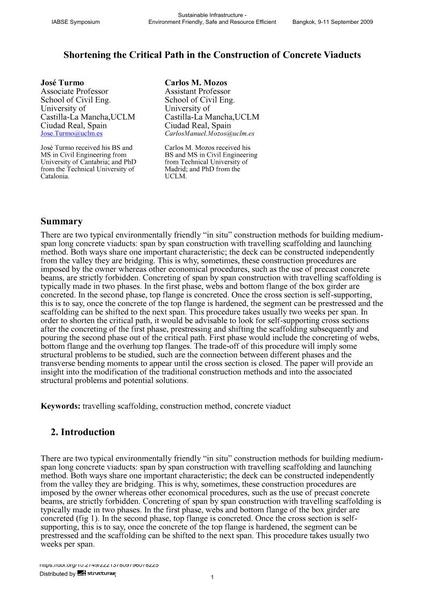Shortening the Critical Path in the Construction of Concrete Viaducts

|
|
|||||||||||
Bibliographic Details
| Author(s): |
José Turmo
Carlos M. Mozos |
||||
|---|---|---|---|---|---|
| Medium: | conference paper | ||||
| Language(s): | English | ||||
| Conference: | IABSE Symposium: Sustainable Infrastructure - Environment Friendly, Safe and Resource Efficient, Bangkok, Thailand, 9-11 September 2009 | ||||
| Published in: | IABSE Symposium Bangkok 2009 | ||||
|
|||||
| Page(s): | 92-101 | ||||
| Total no. of pages: | 8 | ||||
| Year: | 2009 | ||||
| DOI: | 10.2749/222137809796078225 | ||||
| Abstract: |
There are two typical environmentally friendly “in situ” construction methods for building medium- span long concrete viaducts: span by span construction with travelling scaffolding and launching method. Both ways share one important characteristic; the deck can be constructed independently from the valley they are bridging. This is why, sometimes, these construction procedures are imposed by the owner whereas other economical procedures, such as the use of precast concrete beams, are strictly forbidden. Concreting of span by span construction with travelling scaffolding is typically made in two phases. In the first phase, webs and bottom flange of the box girder are concreted. In the second phase, top flange is concreted. Once the cross section is self-supporting, this is to say, once the concrete of the top flange is hardened, the segment can be prestressed and the scaffolding can be shifted to the next span. This procedure takes usually two weeks per span. In order to shorten the critical path, it would be advisable to look for self-supporting cross sections after the concreting of the first phase, prestressing and shifting the scaffolding subsequently and pouring the second phase out of the critical path. First phase would include the concreting of webs, bottom flange and the overhung top flanges. The trade-off of this procedure will imply some structural problems to be studied, such are the connection between different phases and the transverse bending moments to appear until the cross section is closed. The paper will provide an insight into the modification of the traditional construction methods and into the associated structural problems and potential solutions. |
||||
| Keywords: |
construction method travelling scaffolding concrete viaduct
|
||||
